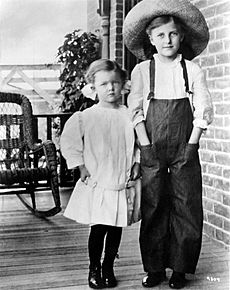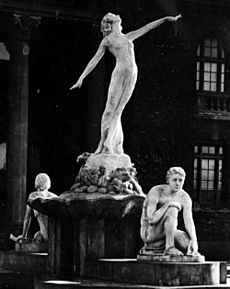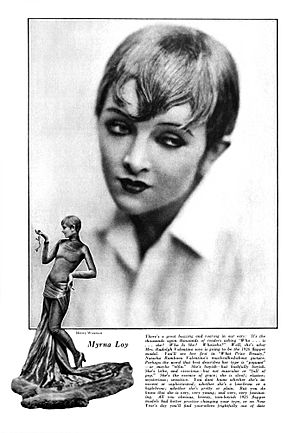Myrna Loy facts for kids
Quick facts for kids
Myrna Loy
|
|
|---|---|
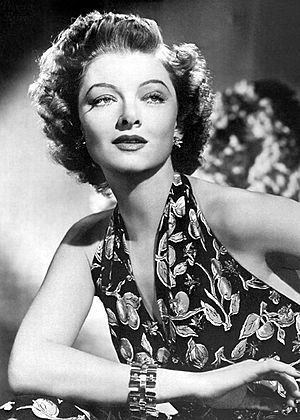
Myrna Loy in 1941
|
|
| Born |
Myrna Adele Williams
August 2, 1905 Helena, Montana, U.S.
|
| Died | December 14, 1993 (aged 88) New York City, U.S.
|
| Resting place | Forestvale Cemetery Helena, Montana, U.S. |
| Other names | The Queen of Hollywood |
| Occupation | Actress |
| Years active | 1925–1982 |
| Political party | Democratic |
| Spouse(s) |
John Hertz, Jr.
(m. 1942; div. 1944)Gene Markey
(m. 1946; div. 1950)Howland H. Sargeant
(m. 1951; div. 1960) |
Myrna Loy (born Myrna Adele Williams; August 2, 1905 – December 14, 1993) was a famous American actress. She starred in movies, television shows, and plays. Myrna Loy was known for being able to change her acting style to match her co-stars.
She was born in Helena, Montana, and grew up in a small town called Radersburg. Later, she moved to Los Angeles with her mother. There, she started learning to dance and trained a lot during high school. A production designer named Natacha Rambova discovered her. Rambova helped Myrna get auditions for films.
Myrna Loy began her acting career with small roles in the late 1920s. At first, she often played "exotic" characters, like a mysterious woman or someone of Asian descent. But her career really took off when she played Nora Charles in the movie The Thin Man (1934). This role made her famous as an actress who could do both serious dramas and funny comedies. She played Nora Charles five more times in other movies.
Myrna Loy's career was at its peak in the 1940s. She starred in popular films like The Best Years of Our Lives and Mr. Blandings Builds His Dream House. In the 1950s, she appeared in fewer movies, including Cheaper by the Dozen (1950). After 1981, she stopped acting.
Even though Myrna Loy was never nominated for an Academy Award for a specific role, she received an Honorary Academy Award in 1991. This award recognized her amazing work in movies and her efforts outside of acting. During World War II, she helped the Red Cross. She was also a member of the U.S. Commission to UNESCO. Myrna Loy passed away in December 1993 in New York City when she was 88 years old.
Contents
Myrna Loy's Early Life and Career
Growing Up in Montana and California
Myrna Adele Williams was born on August 2, 1905, in Helena, Montana. Her parents were Adelle Mae and David Franklin Williams, a rancher. Myrna had a younger brother named David. Her family had roots in Wales, Scotland, and Sweden.
Her father worked as a banker and real estate developer. He was also the youngest person ever elected to the Montana state legislature. Myrna's mother had studied music and wanted to be a concert performer. But she chose to raise Myrna and her brother instead. Myrna Loy grew up following the Methodist faith.
Myrna spent her early childhood in Radersburg, Montana, a small mining town. In 1912, her mother became very sick. Her father sent Myrna and her mother to La Jolla, California, for her mother to recover. Myrna's mother loved Southern California and encouraged her husband to buy land there. He bought land that he later sold to filmmaker Charlie Chaplin for his film studio.
Even though her mother wanted to move to California permanently, her father preferred ranch life. So, they returned to Montana. Later, Myrna's mother needed surgery and insisted on going to Los Angeles for it. Myrna, her mother, and her brother David moved to Ocean Park, where Myrna started taking dancing lessons. When they returned to Montana, Myrna continued her lessons. At 12, she performed her first dance on stage in Helena.
Moving to Los Angeles and Discovering Acting
When Myrna was 13, her father died during the 1918 flu pandemic. After this, Myrna's mother moved the family to Culver City, near Los Angeles. Myrna attended the Westlake School for Girls. She kept studying dance in downtown Los Angeles. When her teachers didn't like her doing theater outside of school, her mother enrolled her in Venice High School. At 15, Myrna started appearing in local plays.
In 1921, Myrna Loy posed for her sculpture teacher, Harry Fielding Winebrenner. She was the model for the central figure in his sculpture called Fountain of Education. This sculpture was placed at Venice High School in 1923. It showed Myrna's "purity, grace, youthful vigor, and aspiration." This was the first time her name appeared in a newspaper.
Myrna left school at 18 to help her family with money. She got a job at Grauman's Egyptian Theatre. There, she performed in musical shows before the main movies. During this time, she saw a play by Eleonora Duse. Duse's simple acting style greatly influenced Myrna, and she tried to act like that throughout her career.
Starting a Film Career
While Myrna Loy was dancing at the Grauman's Egyptian Theatre, a photographer named Henry Waxman took her pictures. The famous actor Rudolph Valentino saw these photos. Valentino was looking for an actress for his new film, Cobra. Myrna auditioned, but the role went to another actress. Soon after, she was hired as an extra for the movie Pretty Ladies (1925). In this film, she and another new actress, Joan Crawford, were chorus girls.
Natacha Rambova then hired Myrna for a small but noticeable role in What Price Beauty?. This film was shot in 1925, but wasn't released for three years. However, pictures of Myrna in her exotic costume appeared in Motion Picture magazine. This led to a contract with Warner Bros.. At Warner Bros., her last name was changed from Williams to Loy.
In her early silent film roles, Myrna Loy often played a "vamp" or a mysterious woman. She frequently played characters of Asian or Eurasian background. Some of these films included Across the Pacific (1926) and The Black Watch (1929). Myrna later said these roles "solidified my exotic non-American image." It took her years to get different types of roles. In 1932, she even played a villainous Eurasian character in Thirteen Women. She also acted alongside Boris Karloff in The Mask of Fu Manchu (1932).
In 1934, Myrna Loy appeared in Manhattan Melodrama with Clark Gable and William Powell. This film became very famous when gangster John Dillinger was shot after leaving a screening of the movie. Some newspapers even reported that Myrna Loy was Dillinger's favorite actress.
Becoming a Hollywood Star
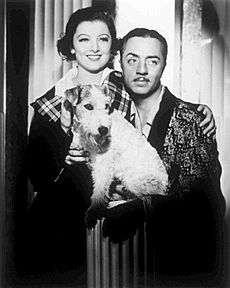
After starring in The Barbarian (1933), Myrna Loy was chosen to play Nora Charles in the 1934 film The Thin Man. The director, W. S. Van Dyke, saw a clever and funny side to Myrna that her earlier films hadn't shown. He even pushed her into a swimming pool at a party to see how she would react! He felt her calm reaction was perfect for Nora's character.
At first, studio head Louis B. Mayer didn't want Myrna to play the part. He thought she was only good for serious roles. But Van Dyke insisted. Mayer finally agreed, as long as the movie was finished quickly. The Thin Man became a huge hit and was even nominated for an Academy Award for Best Picture. Myrna Loy received great reviews for her comedic acting. She and her co-star William Powell became a very popular screen couple. They made 14 films together, which is one of the most successful pairings in Hollywood history. Myrna Loy later said The Thin Man was the film that "finally made me... after more than 80 films."
Her success in Manhattan Melodrama and The Thin Man changed her career. She started getting roles in more important movies. Films like Wife vs. Secretary (1936) with Clark Gable and Jean Harlow helped her develop her comedic skills. She made four movies in a row with William Powell: Libeled Lady (1936), The Great Ziegfeld (1936), After the Thin Man (1936), and Double Wedding (1937). Myrna Loy married Arthur Hornblow Jr. in 1936.
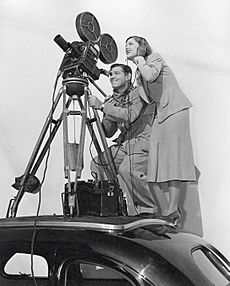
She also made three more films with Clark Gable at Metro-Goldwyn-Mayer (MGM). While Parnell (1937) was not well-received, their other films together, Test Pilot and Too Hot to Handle (both 1938), were very successful. Myrna Loy was not afraid to speak out against unfair casting at MGM, especially when it came to race. She once said, "Why does every black person in the movies have to play a servant? How about a black person walking up the steps of a court house carrying a briefcase?"
During this time, Myrna Loy was one of Hollywood's busiest and highest-paid actresses. In 1937 and 1938, she was listed among the "Top Ten Money Making Stars." This list was based on how much money stars' movies earned in theaters across the United States.
War Efforts and Later Films
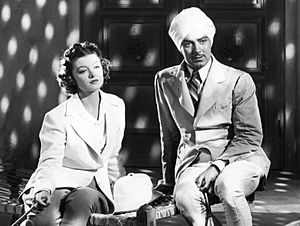
By the late 1930s, Myrna Loy was famous for romantic comedies. But she wanted to show her skills in serious dramas too. She played the main female role in The Rains Came (1939) with Tyrone Power. She also made several more films with William Powell, including I Love You Again (1940) and Love Crazy (1941).
In 1942, Myrna Loy divorced Arthur Hornblow. Five days later, she married John D. Hertz, Jr., an advertising executive. They were married for two years before divorcing in 1944.
With the start of World War II, Myrna Loy almost stopped acting to help with the war effort. She spent her time working with the Red Cross. She spoke out strongly against Adolf Hitler, so much so that her name was put on his "blacklist." This meant her films were banned in Germany. She also helped run a Naval Auxiliary canteen and traveled often to raise money for the war. Around 1945, Myrna Loy started dating producer and screenwriter Gene Markey. They married in 1946.
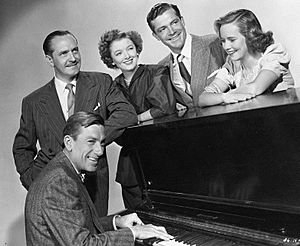
She returned to films with The Thin Man Goes Home (1945). In 1946, she played the wife of a returning soldier, Fredric March, in The Best Years of Our Lives. This film was very successful. Myrna Loy then starred with Cary Grant in The Bachelor and the Bobby-Soxer (1947), which also featured a young Shirley Temple. After this success, she appeared with Grant again in Mr. Blandings Builds His Dream House (1948).
Later Career and Public Service
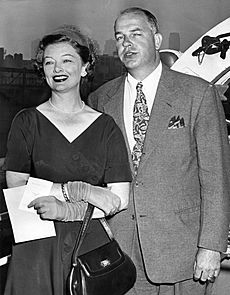
In 1950, Myrna Loy co-starred with Clifton Webb in Cheaper by the Dozen. This movie was a big hit. The same year, she divorced Gene Markey. Her fourth and final husband was Howland H. Sargeant, who worked for the U.S. government and was president of Radio Liberty. They married in 1951.
Throughout the 1950s, Myrna Loy became an important leader. She was co-chairman of a group that fought against housing discrimination. In 1948, she became the first Hollywood celebrity to join the U.S. National Commission for UNESCO. In 1952, she starred in the sequel to Cheaper by the Dozen, called Belles on Their Toes. She also appeared in The Ambassador's Daughter (1956) and Lonelyhearts (1958).
In 1960, she appeared in Midnight Lace and From the Terrace. She didn't make another film until The April Fools in 1969. In 1965, Myrna Loy won the Sarah Siddons Award for her work in theater in Chicago. Myrna Loy was a lifelong Democrat. She publicly supported John F. Kennedy in 1960. She also supported other Democratic candidates in later elections.
After divorcing her fourth husband in 1960, Myrna Loy moved to Manhattan in New York City. In 1967, she appeared in the television series The Virginian and "Family Affair." In 1972, she was in an episode of the TV series Columbo. In 1974, she had a supporting role in Airport 1975. In 1975, Myrna Loy was diagnosed with breast cancer. She had surgery to treat it. She kept her cancer diagnosis private until her autobiography was published in 1987.
In 1978, she appeared in the film The End. Her last movie role was in 1980 in Just Tell Me What You Want. She also returned to the stage, making her Broadway debut in 1973.
Her last acting role was a guest appearance on the sitcom Love, Sidney in 1982. In 1981, she appeared in the TV drama Summer Solstice, which was Henry Fonda's last performance.
Final Years and Legacy
In January 1985, Myrna Loy was honored by the Academy of Motion Picture Arts and Sciences at Carnegie Hall in New York City. Her autobiography, Myrna Loy: Being and Becoming, was published in 1987. The next year, she received a Kennedy Center Honor.
Even though Myrna Loy was never nominated for an Academy Award for a single performance, she received a 1991 Academy Honorary Award for her entire career. She accepted the award from her home in New York City, saying, "You've made me very happy. Thank you very much." This was her last public appearance.
Myrna Loy passed away at age 88 on December 14, 1993, in New York City. She had been ill for some time. She was cremated in New York, and her ashes were buried in Forestvale Cemetery in her hometown of Helena, Montana.

For her contributions to the film industry, Myrna Loy has a star on the Hollywood Walk of Fame at 6685 Hollywood Boulevard.
A building at Sony Pictures Studios in Culver City is named in her honor. Her handprint and signature are in the sidewalk in front of Theater 80 in New York City.
In 1991, the Myrna Loy Center for the Performing and Media Arts opened in downtown Helena, Montana. This center hosts live performances and shows unique films for the community.
Filmography
Images for kids
See also
 In Spanish: Myrna Loy para niños
In Spanish: Myrna Loy para niños


